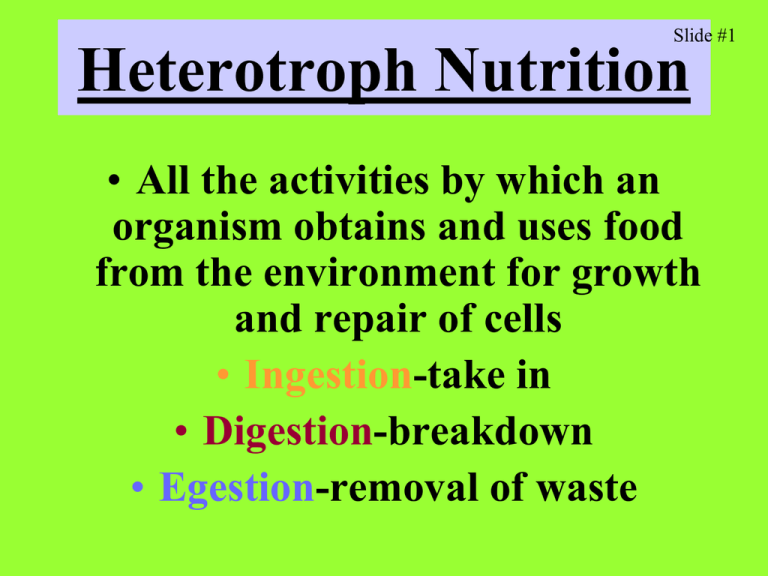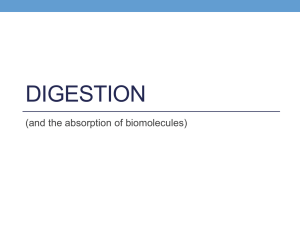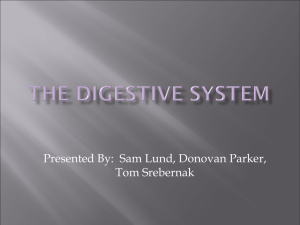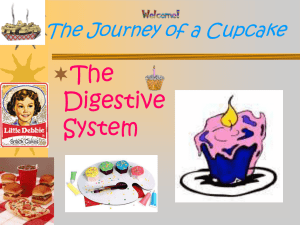
Slide #1
Heterotroph Nutrition
• All the activities by which an
organism obtains and uses food
from the environment for growth
and repair of cells
• Ingestion-take in
• Digestion-breakdown
• Egestion-removal of waste
Slide #2
Ingestion:
Phagocytosis (solid) / Pinocytosis (liquid)
Digestion:
Lysosome enzymes in food vacuole
Egestion:
Exocytosis
Types of Ingestion or Endocytosis:
Pinocytosis (cell drinking)
Process where cell membrane “pinches in”
drawing molecules into the cell forming a
pinocytic vesicle
Phagocytosis (cell eating)
Process where pseudopods of a
cell flow around matter and engulf it
forming a food vacuole.
Pseudo= false and Pod = foot
Pseudopod = false foot
Slide #3
Phagocytosis
Phagocytosis
Requires ATP Energy
Slide #4
Ingestion: Cilia beat food into oral groove
and gullet forms food vacuole
Digestion: Lysosome enzymes in food vacuole
Egestion: Waste out anal pore
Nutrients
Slide #5
• The substances in food that an
organism needs and uses for its
life functions
Slide #6
Function of Nutrients
1. They act as a fuel to provide energy
for the life activities of cells
2. They supply chemicals needed for
growth and repair of cells
3. They regulate proper functioning
of the cell
How do we get the nutrients we need to maintain life
activities?????
Slide #7
Alimentary Canal: (Extra-cellular Digestion)
Tube within a tube body construction
Mouth
Pharynx
Esophagus
Stomach
Small Intestine
Large Intestine
Rectum
Anus
Accessory Organs
Salivary Glands
Pancreas
Liver
Human Digestive system
Slide #8
Pharynx
Salivary Glands
Esophagus
Liver
Gall Bladder
Colon
Large Intestine
Appendix
Anus
Mouth
Teeth/Tongue
Stomach
Pancreas
Small Intestine
Rectum
Slide #9
Mouth & Pharynx:
Click to enlarge
Mechanical Digestion:
- breaks foods into smaller
pieces
- increases surface area
- chewing, grinding, crushing (tongue)
Chemical Digestion:
- salivary glands release amylase (starch maltose)
(works best at pH 8)
Note: Epiglottis covers opening of trachea
Which type of digestion is the
following?
1. Chewing a saltine? 2. Saliva breaking the saltine down into molecules of
glucose? 3. Your tongue breaking pieces of a hamburger apart?
4. Pepsin (an enzyme) in your stomach breaking the
hamburger into amino acids?
Slide #10
Slide #11
Esophagus:
- connects pharynx to stomach
- peristalsis (wave of muscular contractions of
alimentary canal)
Stomach: (holds 2 liters of food)
Mechanical Digestion – churning of stomach
Chemical Digestion – glands
Gastric Gland
secretes acidic gastric
juices (pH 2)
contains HCl
contains enzyme pepsin
(proteins smaller polypeptides)
Slide #12
Slide #13
What stimulates gastric juice flow?
1) thought, smell, sight, and taste
2) food entering the stomach
3) food touching stomach lining
liquids pass through stomach in 20 minutes
solids pass through in 2-6 hours
Hunger pains are churning of empty stomach
Ulcer caused by excess gastric juice digesting
part of stomach wall
Slide #14
Gastric Bypass Surgery
Small Intestine
Small Intestine:
- Length = 6.5 meters
- Diameter = 2.5 cm
- pH 8
Functions:
Chemical Digestion (most)
Absorption of Nutrients
Peristalsis:
moves food through intestine
mixes food with enzymes
mechanical digestion
speeds up absorption
Slide #15
Small Intestine
Slide #16
Slide #17
Liver
Food mixes with:
• Bile
from liver
Gallbladder
• Pancreatic juices from pancreas (*enzymes*)
• Intestinal juices from intestinal glands (*enzymes*)
Bile:
- produced by liver
- stored in gallbadder
- released into upper small intestine
Function:
Emulsification of fats (break into droplets)
Neutralizes acidic contents from stomach
Small Intestine
Absorption:
Slide #18
Circulatory System uses (CAPILLARIES) to absorb::
• simple sugars (glucose)
• amino acids
• vitamins
• minerals
Slide #19
Adaptations that increase surface area of intestine:
Length (6.5 meters or 21 feet)
Lining has folds
Villi (finger-like projections on folded lining)
Absorption involves diffusion and active transport
Slide #20
Regent’s Practice
•
A.
B.
C.
D.
The pancreas is an organ connected to the
digestive tract of humans by a duct through
which digestive enzymes flow. These enzymes
are important to the digestive system because
they:
Form proteins needed in the stomach
Form the acids that break down food
Change food substances into molecules that
can pass into the bloodstream and cells
Change food materials into wastes that can be
passed out of the body.
Large Intestine:
Colon
Slide #21
Length = 1.5 meters
Diameter = 6 cm
No digestion occurs here
Function:
• Absorption of water
- Diarrhea (too little absorption)
- Constipation (too much absorption)
• Bacteria produce vitamin K and various vitamin B
Note: Appendix is attached between small and large
intestine (vestigial organ)
Slide #22
the quest for Polyps
• Colonoscopy:
Slide #23
Large Intestine
( Colon Polyps_)
• Polyps are small growths on the inner
colon lining that look like warts.
Slide #24
Removal Colon Polyps_)
You may be more likely to get colon polyps if you:
•eat a lot of fatty foods
•smoke
•drink alcohol
•don’t exercise
•weigh too much
Rectum:
Slide #25
• temporary storage of feces (stool)
• feces is primarily undigested material
Anus:
(anal sphincter)
• releases waste into environment (egestion/defecate)
Slide #26
End Products of Digestion
(Hydrolysis)
Proteins
Carbohydrates glucose
Lipids fatty acids + glycerol
amino acids
Slide #27
Regent’s Practice
• Organic compounds, such as proteins and
starches, are too A to diffuse into cells.
Proteins are digested to B and starches are
digested to C.
A. A- large, B-simple sugars, C- amino acids
B. A- small, B-simple sugars, C-amino acids
C. A-large, B-amino acids, C-simple sugars
D. A-small, B-amino acids, C-simple sugars
Slide #28
Disorders
of the
Digestive Tract
Body Atlas: Digestive Problems
Heartburn
Slide #29
• ACID from the stomach backs up into the
esophagus.
Slide #30
Constipation
To much water is absorbed by the
large intestine.
Also can exist due to lack of
roughage.
Results in solid/hardened stool
Slide #31
Diarrhea
Decreased water absorption
and increased peristaltic
activity of large intestine.
Results in an increased
watery feces.
Gallstones
Slide #32
An accumulation of hardened
cholesterol deposits in the
gall bladder.
Can either be “passed” (OUCH!!) or
surgically removed
Slide #33
Nutritional Requirements
• RDA- recommended daily allowance
• intake level of a nutrient considered sufficient
Slide #34
Nutritional requirements
vary with individuals:
age
sex
height
weight
activities
Recommended Daily Calories For Men
Slide #35
Middle Age Group With Moderate Activity :
5'4 119-155 2,548
5'5 133-160 2,596
5'6 127-164 2,644
6'0 151-193 2,932
6'1 155-198 2,980
6'2 159-203 3,028
5'7
5'8
5'9
5'10
6'3
6'4
6'5
6'6
131-169
135-174
139-179
143-184
2,692
2,740
2,788
2,836
5'11 147-188 2,884
163-208
167-212
171-217
175-222
3,076
3,124
3,172
3,220
Recommended Daily Calories For Women
Slide #36
Middle Age Group With Moderate Activity :
4'11 90-120 2,100
5'0 93-124 2,133
5'1 97-128 2,177
5'2 100-132 2,210
5'3 104-137 2,254
5'4 107-140 2,287
5'5 111-145 2,331
5'6 114-149 2,364
5'7 118-154 2,408
5'8 121-157 2,441
5'9 125-162 2,485
5'10 128-166 2,518
5'10 128-166 2,518
5'11 132-170 2,562
6'0 135-174 2,595
6'1 139-178 2,639
6'2 142-182 2,672
Fast Food Nutritional Info
Slide #37
Whopper w.Cheese
Vanilla Shake –
Super Size Fries
Diet Coke
Supposed to be:
760 CAL.
small 360 CAL
540 CAL
0 CAL
1660 CAL
Fast Food Nutritional Info
Regular Slice Cheese Pizza
Slide #38
380 Cal
Regular Slice Sausage Pizza 495 Cal
Regular Slice Pepperoni Pizza 427 CAL
Supposed to be:
1302 CAL
Click to return










